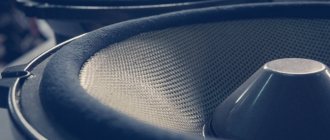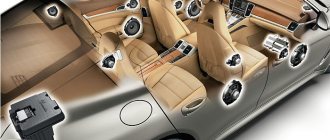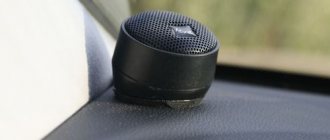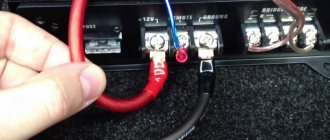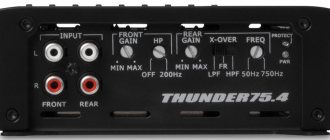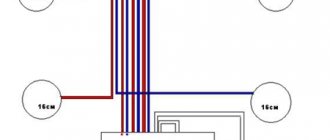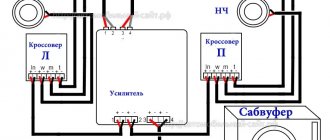Articles
- 2 History
- 3 The magical sound of horn systems
- 4 Horn acoustics in cars
4.1 Advantages and disadvantages of horn acoustics
Horn acoustics
Horn acoustics have always been more expensive than conventional ones. And it is not surprising that the most ardent fans of such acoustics are those users who once owned traditional speakers. There is nothing surprising about this. A sophisticated listener will always appreciate the overall harmony, integrity of perception and natural sound. The user himself likes horn acoustics due to its musicality and ability to captivate the listener.
What it is
Horn acoustic systems
Modern audio equipment is capable of reproducing the entire range of required frequencies. This may be enough to convey musical compositions, but it is completely insufficient to create a sense of the listener’s presence. As any music lover will tell you, there is something that is responsible for conveying not just music and melody, but also for conveying the emotions of the performer. Horn acoustics do this job just fine. Horn acoustics are designed differently from conventional ones. The speaker (see How to choose speakers on your own) is not very large in size and is connected to a horn, which increases the volume of its sound. This can be compared to the case when a person, in order to shout to his interlocutor at a great distance, folds his hands into a megaphone.
Horn loudspeaker systems
Note. If you are thinking about purchasing horn speakers for your car, we hasten to warn you: the difference between good and bad horn speakers is very significant than is observed in traditional options. Cheap horn acoustics made by an unscrupulous manufacturer cannot serve as a comparison. It was these cheap options that gave rise to rumors that supposedly horn acoustics are good, but the sound in them is colored.
As for high-quality horn speakers, they are always expensive. They always use Alnico magnets and exotic metal diaphragms. Horn acoustics are always assembled according to strict tolerances and dimensions. In short, such a production technology cannot imply any compromises or cost reductions.
1000 euro super twitter TAD
Let's give examples. The two-inch TAD compression driver used in all Cesaro horn acoustics models costs about 1 thousand euros. At the same time, the most expensive tweeter today is the Scan Speak with a beryllium diaphragm and it costs only about $600.
Acoustic system folded horn
Horn acoustics for cars are always unique products produced in series. The names of some are written in golden letters in the history of car audio. For example, this is the Japanese horn acoustics Maxonic, produced since 1932. Today Maxonic always presents high-tech products. When creating, expensive technologies are always used using magnetic systems in emitters.
Design of a horn loudspeaker using the example of the ROXTON HP-15CPT model
Figure 4 shows the ROXTON RG line, including the ROXTON HP-15CPT model, see also the article “Review of the ROXTON line and new loudspeaker products.”
Fig. 4 - Line of horn loudspeakers produced by ROXTON
The effectiveness of this model is achieved by optimal coordination of the design, shape and material from which it is made. High sound pressure and good sound quality are ensured by physical and technological advantages: optimal coordination of electro-mechanical and mechanical-acoustic parts with the shape of the horn. Due to its rigid design, this horn has high efficiency, and high-quality material ensures the possibility of its long-term use. A well-matched driver provides a wide frequency range and fairly high uniformity of the frequency response of sound pressure, see below.
The loudspeaker is made of durable, frost-resistant ABS plastic and has a high degree of shell protection (IP-66), which allows it to be used in open areas under conditions of significant temperature changes. The horn's opening edges are protected with high-performance polyvinyl chloride (PVC) material to give the horn additional strength and minimize non-linear distortion, as well as provide additional protection against damage.
Figure 5 shows the electrical connection diagram for the ROXTON HP-15CPT RG.
Fig. 5 — Electrical diagram for connecting the horn loudspeaker ROXTON HP-15CPT
This horn loudspeaker is designed for use in 30/70/100V broadcast lines. The RG is equipped with a step-down matching transformer designed for:
- Galvanic isolation of the high-voltage warning line and the RG driver
- To reduce the voltage in order to match the impedance of the 100V line with the impedance (8 Ohms) of the driver.
The transformer consists of 3 taps:
- COM - common wire
- Tap 15W (white) - maximum power
- 7.5W tap (green) - half power.
The indicated power values correspond to the impedances of the primary winding of the matching transformer: 15W - 666 Ohms, 7.5W - 1333 Ohms, (exactly) in a 100V line.
A capacitor with a nominal value of 2.2 μF, connected in series to the common tap of the transformer, is designed to limit low LF frequencies in order to increase the efficiency of the RG, as well as to work with warning systems in which lines are monitored either according to the EN 54-16 standard or according to the scheme DC control (with terminating resistor at the end of the line).
When working in lines with voltage U
P=U2/666 - for 15W output (white),
P=U2/1333 - for 7.5W output (green),
where U is the line voltage, V.
Story
So:
- It will be interesting to know that the very first loudspeakers in the world were of the horn type. They appeared back in the 20s of the last century. The technology for creating it was unique and they simply didn’t know how to make other acoustic systems;
- Ten years later, speakers appear that are already similar to today's versions of traditional acoustics. They immediately gained great popularity, but they forgot about horn acoustics. At that time, it was mistakenly believed that the ideal place for horn acoustics would be for sounding large spaces, but it was simply not suitable for pleasant listening to music;
- Another ten years pass and the famous American engineer creates a completely new design of horn acoustics. It was Paul Klipsch (that was the name of the engineer) who proved that horn acoustics would allow the reproduction of musical compositions with very high quality.
Note. It was then that the engineer founded a company for the production of horn acoustics, which to this day is a world leader. The company was called Klipsch, and speakers of this type were called “Clipsch.”
- It’s interesting that music lovers immediately realized that the clips reproduced music in a special way. Since that time, horn acoustics have become the choice of a rather narrow circle of connoisseurs of real music;
Horn acoustics Klipsch
- The second half of the last century was marked by the emergence of completely new carriers. In addition, the latest developments and new approaches for processing and amplifying the audio signal are emerging;
- Finally, having reached the apogee of modernization and improvement, people began to understand that the sound could not be given “liveness”. And then the eyes of many turned to horn acoustics, for which a real boom began about three years ago.
Bibliography
- GOST R 53325-2012 “Fire fighting equipment. Fire automatic equipment. General technical requirements and test methods".
- GOST R 42.3.01-2014 “Technical means of warning the population.”
- GOST R 53033-2008 “Horn loudspeakers”.
- GOST R 53575-2009 (IEC 60268-5:2003) Loudspeakers. Methods of electroacoustic tests.
- Set of rules SP-3-13130-2009 from 2009 “Fire safety requirements for sound and voice warning and management of evacuation of people.”
- Sh.Ya. Vakhitov, Yu.A. Kovalgin, A.A. Fadeev, Yu.P. Shevyev. Acoustics (Moscow, 2009).
- GOST 31295.2-2005. Noise. Attenuation of sound as it propagates over terrain. Part 2. General method of calculation, date of introduction 2007-01-01.
Deputy General Director of the ESCORT Group of Companies for Scientific and Technical Development Oleg Vladimirovich Kochnov
The magical sound of horn systems
So:
- It’s not difficult to verify that horn acoustics sound special. And there are all the prerequisites for such a sound. Firstly, horn acoustics are highly sensitive. This makes it possible to reproduce the most subtle nuances and convey the emotions of the performer;
- Secondly, horn speakers produce sound waves that are more “natural” in nature compared to the air vibrations coming out of traditional speakers;
- Horn acoustics can reproduce low frequencies, but their size depends on this. In other words, the lower frequencies you have to reproduce, the larger the size of the horn speaker must be.
Note. It is for this reason that horn acoustics are mostly used to reproduce midrange and high frequencies, but if you choose larger speakers, then the low frequencies will also be reproduced at the highest level.
- And that is not all. Low frequencies will be reproduced not just like that, but at the highest level. True, only the most subtle connoisseurs of sound can distinguish the difference in reproduction.
Note. It is interesting that recently there are quite often speakers where only the HF emitters are made in the form of a horn. For example, the same speakers of the Klipsch Reference series are made according to this model.
- High frequencies reproduced by horn speakers sound much louder. Needless to say, the HF quality is better than when using conventional tweeters.
Homemade horn acoustics
Recently, among the manufacturers of horn acoustics, I would like to single out the Italian company Zingali. The engineers of this company created an original horn emitter that simultaneously reproduces midrange and highfrequency frequencies, and at the same time looks beautiful.
Kinds
There are a huge number of subtypes of Hi-End acoustics designed for a wide variety of conditions:
- concert;
- automobile;
- home;
- for open areas;
- and etc.
The market offer allows each person to choose exactly what he needs.
The range of acoustics is very wide
Horn acoustics in cars
Needless to say, all traditional car speakers do not allow you to achieve high sound quality. The problem is not anything, but the cramped interior. Horn speaker systems will give you the chance to significantly enhance the sound and create the effect of presence (as if you were sitting in a studio or at a concert). Everything can be explained simply: a horn increases the distance over which sound waves propagate, while simultaneously increasing the density of sound and imparting a characteristic melody. Technical solutions for placing such acoustics in a car can be different:
- So, the most popular way is to install a loudspeaker in front, frontally on the wall of the housing, inside which the main waveguide is formed. It has an outlet to the outside;
- Another option involves a horn system with a low-frequency loudspeaker. It is placed in a separate building. The same fate follows the tweeters and midrange speakers, which are also placed in the corresponding housing separately from each other.
Where to install
Manufacturers suggest that car enthusiasts install tweeters as high as possible. Preferably at ear level. However, doing this in a car dealership can be quite difficult. Therefore, most often the horn is placed:
- in the corners of car mirrors;
- on the front panel of the car.
In the first case, compact speakers fit quite organically into the car interior and do not interfere with the driver’s control of the car. However, to install the tweeter in the corners of the side mirrors, you will need a special podium, which is quite difficult to make at home.
The second option for placing horns may not look so aesthetically pleasing. But you can install the tweeter on the front panel on a standard podium. Alternatively, you can simply attach the compact speaker to the panel body using regular double-sided tape.
Now let's talk about the direction of the speakers. Currently, tweeters have two options:
- diagonally (left speaker to the right seat, and right tweeter to the left seat);
- directly at the audience (both horns “look” at the driver’s seat).
The choice in this case depends on the preferences of the car owner and the features of the car interior.
Another option for placing a tweeter is also popular. In this case, we are talking about powerful audio systems with a low-frequency amplifier, each of the elements of which - a high-frequency horn, a midrange speaker and a low-frequency amplifier - is located in its own section of a special housing. Such audio systems are quite bulky and are placed in the trunk of a car.

